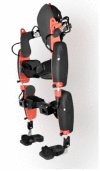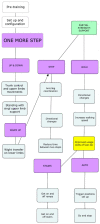Rehabilitation Program for Gait Training Using UAN.GO, a Powered Exoskeleton: A Case Report
- PMID: 35736624
- PMCID: PMC9227123
- DOI: 10.3390/neurolint14020043
Rehabilitation Program for Gait Training Using UAN.GO, a Powered Exoskeleton: A Case Report
Abstract
Background: Spinal cord injury is characterized by the interruption of neural pathways of the spinal cord, with alteration of sensory, motor, and autonomic functions. Robotic-assisted gait training offers many possibilities, including the capability to reach a physiological gait pattern.
Methods: A training protocol with UAN.GO®, an active lower limb exoskeleton, was developed. A participant having D10 complete SCI was recruited for this study. The training protocol was composed by 13 sessions, lasting 1.5 h each. The effectiveness of the protocol was evaluated through the mobility performance during the 6 MWT, the level of exertion perceived administrating Borg RPE at the end of each 6 MWT. Furthermore, time and effort required by the participant to earn a higher level of skills were considered.
Results: A significant improvement was registered in the six MWT (t0 = 45.64 m t1 = 84.87 m). Data referring to the mean level of exertion remained stable. The patient successfully achieved a higher level of independence and functional mobility with the exoskeleton.
Discussion: The findings from this preliminary study suggest that UAN.GO can be a valid tool for walking rehabilitation of spinal cord injury patients, allowing the achievement of greater mobility performances.
Keywords: rehabilitation; robotic exoskeleton; spinal cord injury; walking.
Conflict of interest statement
PT Gianluca Sesenna was one of the UAN.GO developers; all other authors have no conflict to disclose.
Figures






References
-
- Bennett J., Das J.M., Emmady P.D. StatPearls. StatPearls Publishing; Treasure Island, FL, USA: 2021. [(accessed on 13 October 2021)]. Spinal Cord Injuries. Available online: http://www.ncbi.nlm.nih.gov/books/NBK560721/
-
- Hubscher C.H., Herrity A.N., Williams C.S., Montgomery L.R., Willhite A.M., Angeli C.A., Harkema S.J. Improvements in bladder, bowel and sexual outcomes following task-specific locomotor training in human spinal cord injury. PLoS ONE. 2018;13:e0190998. doi: 10.1371/journal.pone.0190998. - DOI - PMC - PubMed
-
- Nash M.S., Groah S.L., Gater D.R., Jr., Dyson-Hudson T.A., Lieberman J.A., Myers J., Sabharwal S., Taylor A.J. Identification and Management of Cardiometabolic Risk after Spinal Cord Injury: Clinical Practice Guideline for Health Care Providers. Top. Spinal Cord Inj. Rehabil. 2018;24:379–423. doi: 10.1310/sci2404-379. - DOI - PMC - PubMed
Publication types
LinkOut - more resources
Full Text Sources

